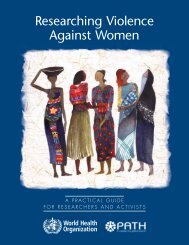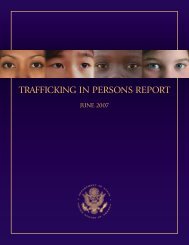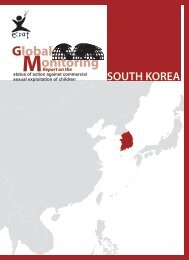Download PDF - Violence Against Children - East Asia and the ...
Download PDF - Violence Against Children - East Asia and the ...
Download PDF - Violence Against Children - East Asia and the ...
Create successful ePaper yourself
Turn your PDF publications into a flip-book with our unique Google optimized e-Paper software.
ecommendations<br />
universities. Advocacy <strong>and</strong> development in<br />
<strong>the</strong> interests of increased child protection<br />
can be streng<strong>the</strong>ned through collaboration;<br />
indeed, unless such linkages are part of<br />
project planning, NGO actions may harm<br />
independent grassroots initiatives that<br />
contribute to social capital. 6<br />
Child <strong>and</strong> youth participation<br />
• Partner with children to support <strong>the</strong>m in<br />
underst<strong>and</strong>ing <strong>and</strong> influencing <strong>the</strong>ir peers.<br />
Recognise, nurture <strong>and</strong> build on <strong>the</strong><br />
resilience that children often display in<br />
extreme situations, which can be an asset<br />
to o<strong>the</strong>r children, families <strong>and</strong> community.<br />
Consider children’s own capacity <strong>and</strong><br />
potential to advocate, which may be<br />
present even when o<strong>the</strong>rs fear to raise<br />
<strong>the</strong>ir voices.<br />
• Invest to better underst<strong>and</strong> factors that<br />
contribute to resilience as well as risk –<br />
<strong>and</strong> how <strong>the</strong>se can be promoted to assist<br />
o<strong>the</strong>rs <strong>and</strong> engage all children – not only<br />
those experiencing difficulty – more fully as<br />
part of <strong>the</strong> solution.<br />
• At <strong>the</strong> same time, seek to streng<strong>the</strong>n<br />
institutions of education <strong>and</strong> health that build<br />
children’s capacity to protect <strong>the</strong>mselves<br />
<strong>and</strong> those around <strong>the</strong>m, <strong>and</strong> to recover from<br />
trauma or injuries <strong>the</strong>y have experienced as a<br />
result of abuse or exploitation.<br />
• Support community-based associations of<br />
children or young people as vehicles for<br />
promoting greater community awareness<br />
<strong>and</strong> ownership of issues that hinder child<br />
protection or limit children’s options.<br />
Promote safe ga<strong>the</strong>ring places for children<br />
as part of project designs. The World Bank<br />
has noted <strong>the</strong> value of linking with youth<br />
networks in promoting healthy behaviour.<br />
• Encourage families, communities <strong>and</strong><br />
community leaders to support child<br />
participation, which has been shown to<br />
increase child protection through increasing<br />
awareness of issues, st<strong>and</strong>ards <strong>and</strong> avenues<br />
of response.<br />
• Support children to work with<br />
community leaders in defining avenues<br />
for action on <strong>the</strong> increasing concerns that<br />
are prompted by child participation.<br />
• Ensure a strong link with schools as a<br />
strategy to increase child participation, in<br />
education <strong>and</strong> beyond.<br />
• Recognise <strong>the</strong> importance of <strong>the</strong><br />
psychological <strong>and</strong> spiritual well-being of<br />
children; cooperate with local initiatives<br />
that are addressing <strong>the</strong>se in appropriate<br />
ways, including those that are faith-based.<br />
Hope of children, although a less tangible<br />
indicator, is a particularly valuable one,<br />
since hope brings energy for change; it is an<br />
investment in both today <strong>and</strong> tomorrow.<br />
• Give greater attention to researching,<br />
documenting, translating <strong>and</strong> distributing<br />
child-to-child approaches <strong>and</strong> material as<br />
part of both program design <strong>and</strong> national<br />
child protection strategies.<br />
• Integrate specific measures, such as<br />
rehabilitation for children with disabilities,<br />
into broader community development<br />
approaches, to ensure attention to children<br />
who are at a high risk of neglect.<br />
Advocacy/partnerships<br />
• Recognise <strong>the</strong> structural or social<br />
dimensions contributing to children being<br />
at risk, <strong>and</strong> seek to support change; for<br />
example, improved law enforcement is one<br />
important measure to protect children<br />
from abuse, exploitation <strong>and</strong> neglect.<br />
• Actively promote justice. Positive change<br />
is achieved through initiatives where this is<br />
a principal aim, not only a guiding principle.<br />
It may be more effective for children for an<br />
agency to choose not to implement a<br />
specific program, opting instead for a<br />
strategic partnership, for example with<br />
human rights groups.<br />
• At <strong>the</strong> community level, work in<br />
partnerships to promote local investment<br />
<strong>and</strong> local accountability for child protection.<br />
• Develop country-specific training, which<br />
defines child exploitation <strong>and</strong> outlines<br />
avenues of response for NGOs <strong>and</strong><br />
community members.<br />
6 Fisher, J, 1998<br />
86

















